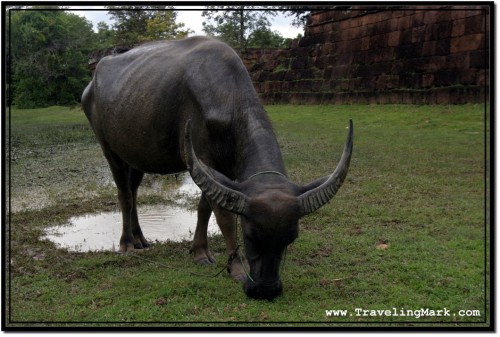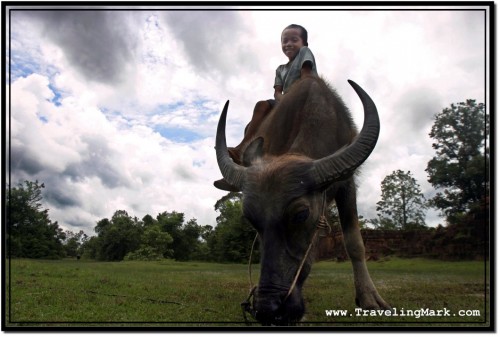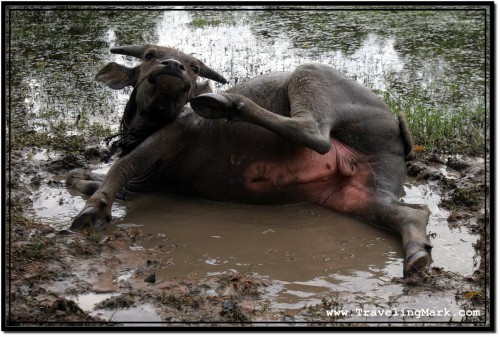I did the Grand Circuit of Angkor in a counter-clockwise direction so after a brief stop at Banteai Kdei where I said “Hi” to my new friends and had a coconut to keep my electrolyte levels high, I rode around Sras Srang moat and headed forward for a few kilometers until I came to the bend that turned the road from going east to going north and there, seemingly abandoned and lacking any form of attention from visitors stood the ruins of the Pre Rup Temple.
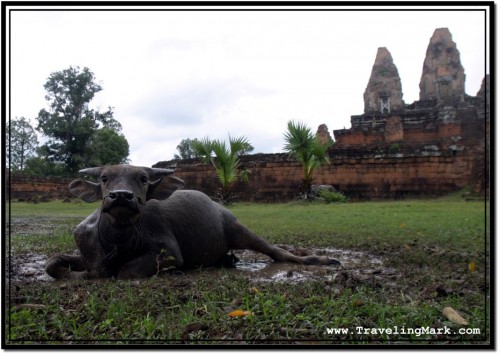
That Pre Rup gets no attention from visitors to Angkor Archaeological Park was evident right away from the fact that there were no actively operating touts. I found it strangely intriguing since Pre Rup is much larger and offers much more to see than many other temple ruins along the Grand Circuit, yet many of those other temples had stalls with souvenirs sold by the locals set up at their entrance gates – signifying that there must be traffic worthy of the effort going through this gate – but not at Pre Rup – again, signifying that the hassle of setting up the stalls and spending whole day there would not pay for itself as the temple simply did not attract any visitors. Worked for me – the less “competition” I have in form of other tourists getting in the view of my camera and the more peace I get in lack of pestering kids who aggressively follow you around and talk till your head explodes, the happier I am. Handling the breezeless heat of the sun at Angkor is difficult enough on its own so any chance to battle it without extra difficulties is an uplifting bonus…
The Only Pre Rup Tout
Still, when I reached Pre Rup, I was not alone. Little boy looking after his family’s water buffalo feeding off of a grassy plane surrounding Pre Rup became my company and even though all he could speak in English were two words, he instantly put them to use as soon as I made myself reachable: “One Dolla!” said the boy as his beaming big eyes twinkled with joy staring once at his stretched out palm and once at me. Since I took pictures of his water buffalo, he made me feel obliged to give him that dollar and kept following me around with his hand beg-stretched until I shelled out. That wasn’t necessarily a good idea as he felt encouraged and kept insisting on more. Giving a Cambodian a finger is a sure fire way to entice them into going after whole hand.
It was early morning yet and I had just started the day with Pre Rup as my first temple ahead of a whole slew of them scheduled to visit that day, but as was shown to me again – there is no supply of energy that can stand up to the power of the sun in Cambodia. I was dripping with sweat, whatever layer of sun block I had applied had long been washed away, my fabric hat looked like a rug pulled out of a sewage drain yet the day has just begun. Midday heat was still hours away so when I realized that the insanity I’m experiencing right now is in fact a mild morning, I instantly knew I was gonna have to grab at every opportunity to buy a coconut and a fresh bottle of water I would come across, if I were to make it. Plus of course there was this realization that I’m heat beat already and I didn’t even have to waste energy on battles with the touts. I did not look forward to what it was going to be like when the heat of the day reaches its peak and hoards of them vultures descend upon me to suck out every bit of life juice I may still have within. And with that, my money – of course.
Why Is Pre Rup So Rarely Visited?
While I was walking among the walls of Pre Rup, absorbing the heat these giant piles of stone radiate, I noticed several foreigners passing by in tuk tuks. Perhaps the demise of Pre Rup lays in the fact that the Grand Circuit road goes right by it and you only spot it in the last moment – especially if you’re in a tuk tuk or a taxi. Riding a bicycle comes with a major disadvantage of not being able to catch any breeze between the temples to have the sweat washed away, but since you move around slowly and don’t have to ask anyone to stop when you see something – not knowing yet whether it’s worth a stop or not – you get to see things people in tuk tuks don’t get to see. Pre Rup temple is one of them.
I can imagine the vast majority of tourists who passed by Pre Rup on a tuk tuk didn’t even notice it was there. They were too worn out from previous temples and were glad they were moving at a decent speed to catch some breeze to pay attention to some random pile of rocks alongside the road. And those who did notice the ruins were just too exhausted from the heat to even ask the tuk tuk driver what the heck it was they just passed by so they simply assumed it was nothing worthwhile and continued on until the tuk tuk driver stopped again. Don’t forget that Cambodia runs vastly on a commission based trade system. Tuk tuk drivers will not take you anywhere out of their own initiative unless there is a kick back in it for them. Regardless of how they present themselves to you, Cambodians never act helpful to help YOU – they are only interested in helping themselves. If what it takes is for them to paint with honey over your face, they will do it. If you can’t read between the lines (most people can’t), you will think Cambodians are the nicest, the most helpful people in the whole wild universe, even though behind your back, without you realizing, they are screwing you right in the arse with no lube.
Pre Rup Temple Mountain
Pre Rup is believed to be the last temple-mountain constructed by the Angkorian civilization. Nearby East Mebon was constructed following the same temple-mountain style but was built a few years prior. The construction works on Pre Rup temple commenced during the rule of Khmer king Rajendravarman II in 961 – after the capital city returned back to Angkor following its temporary move to Koh Ker between 921 and 944.
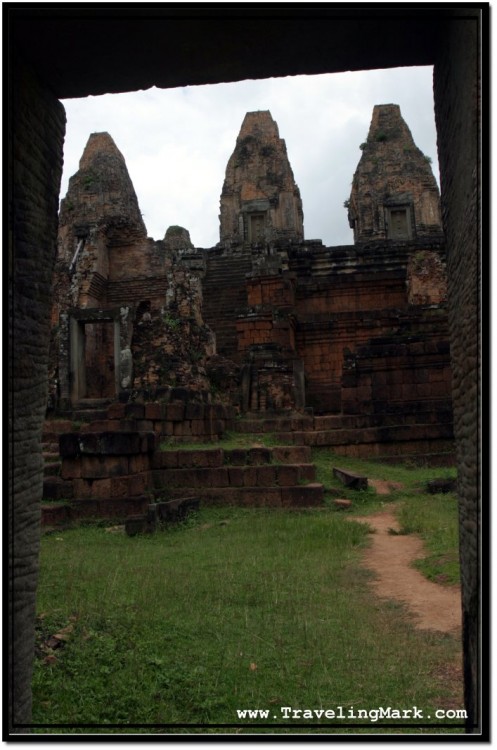
Scientists are still trying to figure out why Cambodians refer to Pre Rup as being a funerary temple given that none of the historical records suggest it being the case. The temple is known by its current name because that’s what modern day Cambodians call it as in their language it means “to turn the body”, which was a rite used during cremation.
Pre Rup is in a great state of ruin. Gopuras (entrance gates) can be found on each side of the outer enclosure, but it’s the best to take the one which has a dirt road leading to it from the main road. There isn’t much left of the gopura, however a guardian lion similar to those found at Bayon still stands at the crumbling stairway.
Sandstone vestibule then leads to the second level enclosure which then affords access to the third tier housing the central sanctuary. It’s a steep set of stairs to take on, but certainly not as bad as, say… central sanctuary of Angkor Wat. The view is quite nice from up there but take good care of your laptop or else you end up with no pictures of it, which is exactly what happened to me.
